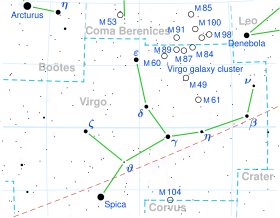
Summary
Chi Virginis (χ Vir, χ Virginis) is a double star in the constellation Virgo. Based upon parallax measurements, it is approximately 315 light-years (97 parsecs) from Earth. It has an apparent visual magnitude of 4.65, which is bright enough to be seen with the unaided eye under suitable viewing conditions.
| Observation data Epoch J2000.0 Equinox J2000.0 | |
|---|---|
| Constellation | Virgo |
| Right ascension | 12h 39m 14.76696s[1] |
| Declination | −07° 59′ 44.0338″[1] |
| Apparent magnitude (V) | 4.652[2] |
| Characteristics | |
| Spectral type | K2 III[3] |
| U−B color index | +1.389[2] |
| B−V color index | +1.239[2] |
| Astrometry | |
| Radial velocity (Rv) | −19.7[4] km/s |
| Proper motion (μ) | RA: −77.223[1] mas/yr Dec.: −24.409[1] mas/yr |
| Parallax (π) | 10.3526 ± 0.1151 mas[1] |
| Distance | 315 ± 4 ly (97 ± 1 pc) |
| Absolute magnitude (MV) | −0.29±0.19[5] |
| Details | |
| Mass | 2.17±0.28[6] M☉ |
| Radius | 23[7] R☉ |
| Luminosity | 182[7] L☉ |
| Surface gravity (log g) | 2.5[7] cgs |
| Temperature | 4,395[7] K |
| Metallicity | 0.06[7] |
| Rotational velocity (v sin i) | 3.9[7] km/s |
| Age | 0.86±0.34[5] Gyr |
| Other designations | |
| Database references | |
| SIMBAD | data |
| Exoplanet Archive | data |
This star has a stellar classification of K2 III,[3] with the luminosity class "III" indicating that this is a giant star that has consumed the hydrogen at its core and evolved away from the main sequence. It has a mass about double that of the Sun[6] and has expanded to 23 times the Sun's radius, giving it a luminosity of 182 times the luminosity of the Sun.[7] The effective temperature of the star's outer envelope is about 4,395 K,[7] which gives the star the orange hue typical of K-type stars.[9] The abundance of elements other than hydrogen and helium, what astronomers term the star's metallicity, is slightly higher than in the Sun.[7]
This star has three optical companions. At an angular separation of 173.1 arcseconds is a magnitude +9.1 star, which is of spectral type K0. A 10th magnitude star is located 221.2 arcseconds away, and the third is a magnitude +9.1 K2 star 321.2 arcseconds away. None of these have been confirmed as a physical companion.[10]
In July 2009, it was discovered that Chi Virginis has a massive planet with a high orbital eccentricity of 0.46. It is orbiting with a period of about 835 days and has a mass at least 11 times greater than Jupiter. There are indications of a second planet orbiting with a period of 130 days, but this has not been firmly established.[11] But on 19 August 2015, the existence of a second planet, HD 110014 c, (about three times bigger than Jupiter and having an orbit roughly that of Venus) was confirmed by Chilean astronomer Maritza Soto.[12]
| Companion (in order from star) |
Mass | Semimajor axis (AU) |
Orbital period (days) |
Eccentricity | Inclination | Radius |
|---|---|---|---|---|---|---|
| b | ≥11.09 ± 1 MJ | 2.14 ± 0.03 | 835.477 ± 6 | 0.462 ± 0.069 | — | — |
See also edit
References edit
- ^ a b c d e Vallenari, A.; et al. (Gaia collaboration) (2023). "Gaia Data Release 3. Summary of the content and survey properties". Astronomy and Astrophysics. 674: A1. arXiv:2208.00211. Bibcode:2023A&A...674A...1G. doi:10.1051/0004-6361/202243940. S2CID 244398875. Gaia DR3 record for this source at VizieR.
- ^ a b c Gutierrez-Moreno, A.; et al. (1966), A System of photometric standards, vol. 1, Publicaciones Universidad de Chile, Department de Astronomy, pp. 1–17, Bibcode:1966PDAUC...1....1G
- ^ a b Buscombe, W. (1962), "Spectral classification of Southern fundamental stars", Mount Stromlo Observatory Mimeogram, 4, Bibcode:1962MtSOM...4....1B
- ^ Wilson, R. E. (1953), General Catalogue of Stellar Radial Velocities, Carnegie Institute of Washington D.C., Bibcode:1953GCRV..C......0W
- ^ a b da Silva, L.; et al. (2006), "Basic physical parameters of a selected sample of evolved stars", Astronomy and Astrophysics, 458 (2): 609–623, arXiv:astro-ph/0608160, Bibcode:2006A&A...458..609D, doi:10.1051/0004-6361:20065105, S2CID 9341088
- ^ a b Kunitomo, M.; et al. (2011), "Planet Engulfment by ~1.5–3 M⊙ Red Giants", The Astrophysical Journal, 737 (2): 66, arXiv:1106.2251, Bibcode:2011ApJ...737...66K, doi:10.1088/0004-637X/737/2/66, S2CID 119208821
- ^ a b c d e f g h i Massarotti, A.; Latham, D. W.; Stefanik, R. P.; Fogel, J. (2008), "Rotational and Radial Velocities for a Sample of 761 HIPPARCOS Giants and the Role of Binarity", The Astronomical Journal, 135 (1): 209–231, Bibcode:2008AJ....135..209M, doi:10.1088/0004-6256/135/1/209, S2CID 121883397
- ^ "chi Vir -- Star in double system", SIMBAD, Centre de Données astronomiques de Strasbourg, retrieved 2011-12-30
- ^ "The Colour of Stars", Australia Telescope, Outreach and Education, Commonwealth Scientific and Industrial Research Organisation, December 21, 2004, archived from the original on 2012-03-18, retrieved 2012-01-16
- ^ Eggleton, P. P.; Tokovinin, A. A. (2008), "A catalogue of multiplicity among bright stellar systems", Monthly Notices of the Royal Astronomical Society, 389 (2): 869–879, arXiv:0806.2878, Bibcode:2008MNRAS.389..869E, doi:10.1111/j.1365-2966.2008.13596.x, S2CID 14878976
- ^ de Medeiros, J. R.; et al. (2009), "A planet around the evolved intermediate-mass star HD 110014", Astronomy and Astrophysics, 504 (2): 617–623, Bibcode:2009A&A...504..617D, doi:10.1051/0004-6361/200911658
- ^ "Astronomer Discovers Planet 3 Times as Large as Jupiter". 20 August 2015.



